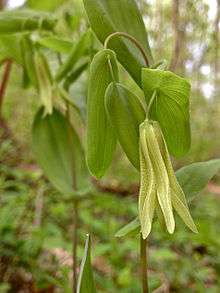Uvularia perfoliata
| Perfoliate bellwort | |
|---|---|
 | |
| Scientific classification | |
| Kingdom: | Plantae |
| (unranked): | Angiosperms |
| Family: | Colchicaceae |
| Genus: | Uvularia |
| Species: | U. perfoliata |
| Binomial name | |
| Uvularia perfoliata L. | |
| Synonyms | |
Uvularia perfoliata (known by the common name perfoliate bellwort) is a perennial forb native to the eastern United States and Canada,[2] which produces pale yellow flowers in spring.
Description

The smooth slender stem of Uvularia perfoliata is 15 to 50 centimeters tall, and forked above the middle. The leaves are obovate, 4 to 12 centimeters long and 1.5 to 4 centimeters wide, glabrous or glaucous, and perfoliate. There are usually 1 to 4 leaves below the fork in the stem. The stems bear a single downward drooping flower with six 2 to 3.5 centimeter long tepals which are granular on the inside. The fruit is a triangular three lobed capsule 7 to 13 millimeters in length.[3][4][5]
Distribution and habitat
Uvularia perfoliata is widely distributed in the eastern and southern United States from Texas to New Hampshire, plus the Canadian province of Ontario. It is listed as an endangered species by the states of Indiana and New Hampshire.[2] In Virginia, it grows in habitats such as floodplain forests, but also mesic upland forests, and dry rocky woodlands.[6] The presence of this species is dependent on appropriate habitat, and it may be eliminated from an area by development, changes in land use, or competition with invasive species.
Taxonomy
This species is a member of the genus Uvularia, which was formerly placed in the Liliaceae family, but has more recently been placed in the Colchicaceae family, in keeping with the findings of the Angiosperm Phylogeny Group.[7]
References
- ↑ "Uvularia perfoliata L. - The Plant List". Retrieved January 26, 2014. The Plant List (2013). Version 1.1. Published on the Internet; http://www.theplantlist.org/
- 1 2 "Plants Profile for Uvularia perfoliata (perfoliate bellwort)". Retrieved January 26, 2014. USDA, NRCS. 2014. The PLANTS Database (http://plants.usda.gov). National Plant Data Team, Greensboro, NC 27401-4901 USA.
- ↑ Britton, Nathaniel Lord & Brown, Addison (1913). An Illustrated Flora of the Northern United States, Canada and the British Possessions: From Newfoundland to the Parallel of the Southern Boundary of Virginia, and from the Atlantic Ocean Westward to the 102d Meridian, Volume 1., p. 518. Charles Scribner's Sons, New York.
- ↑ "Uvularia perfoliata (perfoliate bellwort): Go Botany". Retrieved February 9, 2014. Copyright © 2011-2013 New England Wild Flower Society (http://www.newenglandwild.org)
- ↑ "Uvularia perfoliata in Flora of North America @ efloras.org". Retrieved February 9, 2014. 'eFloras (2008). Published on the Internet (http://www.efloras.org). Missouri Botanical Garden, St. Louis, MO & Harvard University Herbaria, Cambridge, MA.
- ↑ "Digital Atlas of the Virginia Flora | Uvularia perfoliata L.". Retrieved January 26, 2014. Virginia Botanical Associates. (2014). Digital Atlas of the Virginia Flora (http://www.vaplantatlas.org). c/o Virginia Botanical Associates, Blacksburg.
- ↑ Angiosperm Phylogeny Group. 2003. An update of the Angiosperm Phylogeny Group classification for the orders and families of flowering plants: APG II. Botanical Journal of the Linnaean Society 141:399-436., cited in Walter Fertig "Farewell to the Aceraceae: Changes in the Angiosperm Family Tree" (PDF). Retrieved February 9, 2014. The University of Montana Herbarium Newsletter. (Spring 2011). University of Montana, Missoula, MT. http://herbarium.dbs.umt.edu